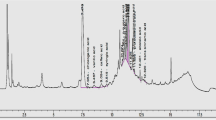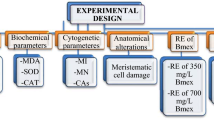Abstract
In this study, the toxic effects of paraquat, one of the most commercially sold herbicides in the world, and the protective role of green tea leaf extract (GTLE) against these effects were investigated. Allium cepa L. bulbs (n = 16) were used as test material. One hundred milligrams per liter dose of paraquat and 190 and 380 mg/L doses of GTLE were preferred. Paraquat toxicity was investigated with the help of physiological (percent germination, root length, and weight gain), cytogenetic (mitotic index = MI, micronucleus = MN, and chromosomal damages = CAs), biochemical (superoxide dismutase = SOD, catalase = CAT, malondialdehyde = MDA), and anatomical (meristematic cell damages) parameters. A. cepa bulbs were divided into 6 groups as 1 control and 5 applications. The control group was germinated with tap water, and the application groups were germinated with paraquat and two different doses of GTLE. Germination was carried out at room temperature for 72 h. At the end of the period, A. cepa bulbs were prepared for physiological, cytogenetic, biochemical, and anatomical analyzes using routine preparation techniques. As a result, paraquat application caused a decrease in physiological parameters and an increase in cytogenetic (except MI) and biochemical parameters. Compared to the control (group I), the germination percentage decreased by 38%, root length 12.5 times, and weight gain 5 times decreased in group IV treated with paraquat. MDA level increased 2.58 times, SOD activity 2.48 times, and CAT activity 4.51 times increased. Paraquat application caused a decrease in the percentage of MI and an increase in the number of MN and CAs. Paraquat application caused CAs in the form of fragment, sticky chromosome, unequal distribution of chromatin, bridge, nucleus with vacuoles, nucleus bud, and reverse polarization. In the meristematic cells of the root tips applied paraquat, unclearly vascular tissue, flattened cell nucleus, epidermis, and cortex cell deformation were observed. The application of GTLE together with paraquat caused an increase in the physiological parameter values and a decrease in the cytogenetic (except MI) and biochemical parameter values. An improvement in the severity of damages induced by paraquat was also observed in root tip meristematic cells. It was determined that the improvements observed in all these parameters were related to the dose of GTLE applied. The 380 mg/L dose of GTLE provided more protection than the 190 mg/L dose. Compared to group IV in which paraquat was applied, the germination percentage increased by 21%, root length 5.83 times, and weight gain 2.92 times increased in group VI administered 380 mg/L dose of GTLE. In addition, MDA level decreased 1.78 times, SOD activity 1.59 times and CAT activity 1.65 times. In conclusion, paraquat administration at a dose of 100 mg/L caused physiological, cytogenetic, biochemical, and anatomical toxicity in A. cepa bulbs. GTLE application, on the other hand, resulted in improvements in the severity of this toxicity induced by paraquat, depending on the dose. Therefore, GTLE can be used as an effective nutritional supplement to reduce or prevent the toxicity caused by environmental agents such as pesticides.




Similar content being viewed by others
Data availability
All data generated or analyzed during this study are included in this article.
References
Acar A, Çavuşoğlu K, Türkmen Z, Çavuşoğlu K, Yalçın E (2015) The investigation of genotoxic, physiological and anatomical effects of paraquat herbicide on Allium cepa L. Cytologia 80(3):343–351. https://doi.org/10.1508/cytologia.80.343
Akashe MM, Pawade UV, Nikam AV (2018) Classification of pesticides: a review. Int J Res Ayurveda Pharm 9(4):144–150. https://doi.org/10.7897/2277-4343.09413
Akgündüz MÇ, Çavuşoğlu K, Yalçın E, Yapar K, Acar A (2019) Protective role of green tea extract against toxicity caused by chronic formaldehyde exposure. Black Sea 1st International Multidisciplinary Scientific Studies Congress, Giresun-Turkey, pp 185–190
Ali S, Jain SK, Abdulla M, Athar M (1996) Paraquat induced DNA damage by reactive oxygen species. IUBMB Life 39(1):63–67. https://doi.org/10.1080/15216549600201061
Atik M, Karagüzel O, Ersoy S (2007) Effect of temperature on germination characteristics of Dalbergia sissoo seeds. Mediterr Agric Sci 20:203–208
Aydın G, Liman R (2020) Cytogenotoxic effects of pinoxaden on Allium cepa L. roots. J Appl Genet 61:349–357. https://doi.org/10.1007/s13353-020-00560-w
Beauchamp C, Fridovich I (1971) Superoxide dismutase: improved assays and an assay applicable to acrylamide gels. Anal Biochem 44(1):276–287. https://doi.org/10.1016/0003-2697(71)90370-8
Beers RF, Sizer IW (1952) Colorimetric method for estimation of catalase. J Biol Chem 195:133–139
Chaneva G, Petrova D (2014) Effect of method of applying the herbicide paraquat on pea and maize. Oxid Commun 37(4):1090–1102
Çanakçı-Gülengül S, Karabulut F (2020) The biochemical changes caused by metolachlor and atra-zine on wheat (Triticum aestivum L) varieties. Prog Nutr 22(3):1–8. https://doi.org/10.23751/pn.v22i3.8336
Çavuşoğlu K, Kurt D, Yalçın E (2020) A versatile model for investigating the protective effects of Ceratonia siliqua pod extract against 1,4-dioxane toxicity. Environ Sci Pollut Res 27:27885–27892. https://doi.org/10.1007/s11356-020-08545-2
Çavuşoğlu K, Yalçın E, Türkmen Z, Yapar K, Çavuşoğlu K, Çiçek F (2011) Investigation of toxic effects of the glyphosate on Allium cepa. J Agric Sci 17(2):131–142. https://doi.org/10.1501/Tarimbil_0000001165
Fenech M, Chang WP, Kirsch-Volders M, Holland N, Bonassi S, Zeiger E (2003) HUMN Project: detailed description of the scoring criteria for the cytokinesis-block micronucleus assay using isolated human lymphocyte cultures. Mutat Res 534(1):65–75. https://doi.org/10.1016/s1383-5718(02)00249-8
Gömürgen AN (2000) Cytological effect of the herbicide 2, 4-D isooctylester 48% on root mitosis of Allium cepa. Cytologia 65(4):383–388. https://doi.org/10.1508/cytologia.65.383
Gupta J, Siddique YH, Beg T, Ara G, Afzal M (2009) Protective role of green tea extract against genotoxic damage induced by anabolic steroids in cultured human lymphocytes. Biol Med 1(2):87–99
Gündüz A, Yalçın E, Çavuşoğlu K (2021) Combined toxic effects of aflatoxin B2 and the protective role of resveratrol in Swiss albino mice. Sci Rep 11(1):1–14. https://doi.org/10.1038/s41598-021-95879-7
Hashmi I, Khan AD (2011) Adverse health effects of pesticide exposure in agricultural and industrial workers of develo** country. In: Pesticides-the impacts of pesticides exposure, pp 156–178. https://doi.org/10.5772/13835
Hu S, Qiao C, Yuan Z, Li M, Ye J, Ma H, Zhang J (2018) Therapy with high-dose long-term antioxidant free radicals for severe paraquat poisoning: a pilot study. Exp Ther Med 16(6):5149–5155. https://doi.org/10.3892/etm.2018.6823
KalefetoğluMacar T, Macar O, Yalçın E, Çavuşoğlu K (2021) Preventive efciency of cornelian cherry (Cornus mas L) fruit extract in diniconazole fungicide-treated Allium cepa L roots. Sci Rep 11:2534. https://doi.org/10.1038/s41598-021-82132-4
Mithöfer A, Maffei ME (2016) General mechanisms of plant defense and plant toxins. Plant Toxins, Springer AG, Switzerland.
MohabbullaMohib M, FazlaRabby SM, Paran TZ et al (2016) Protective role of green tea on diabetic nephropathy—a review. Cogent Biol 2(1):1248166. https://doi.org/10.1080/23312025.2016.1248166
Morales M, Munné-Bosch S (2019) Malondialdehyde: facts and artifacts. Plant Physiol 180(3):1246–1250. https://doi.org/10.1104/pp.19.00405
Ogeleka DF, Okieimen FE, Ekpudi FO, Tudararo-Aherobo LE (2016) Short-term phyto-toxicity consequences of a nonselective herbicide glyphosate (RoundupTM) on the growth of onions (Allium cepa Linn). Afr J Biotechnol 5(18):740–744. https://doi.org/10.5897/AJB2014.14355
OyetakinWhite P, Tribout H, Baron E (2012) Protective mechanisms of green tea polyphenols in skin. Oxid Med Cell Longev 2012:560682. https://doi.org/10.1155/2012/560682
Özen E, Çiçek F, Gür B, Aydın N, Akıncı B, Topal M, Keser G, Çavuşoğlu K (2011) The effects of Paraquat on some cytotoxic and biochemical parameters in Allium cepa. Firat Uni J Sci 23(2):117–124
Prasanth MI, Sivamaruthi BS, Chaiyasut C, Tencomnao T (2019) A review of the role of green tea (Camellia sinensis) in antiphotoaging, stress resistance, neuroprotection, and autophagy. Nutrients 11(2):474. https://doi.org/10.3390/nu11020474
Ranjbar A (2014) Evidence of oxidative damage in paraquat toxicity. Zahedan J Res Med Sci 16(12):1–8
Reddy KBAK, Jeevanalatha M, Lakshman M, Rani MU (2019) The toxic effects of paraquat (PQ) on body weights and haematological parameters in male albino wistar rats and its amelioration with vitamin C. Int J Curr Microbiol App Sci 8(11):314–320. https://doi.org/10.20546/ijcmas.2019.811.039
Sağır S, Çavuşoğlu K, Yapar K (2013) Investigation of physiological and genotoxic effects of 1,4 dioxane on swiss albino mice. EÜFBED 6(2):145–155
Sharma A, Kumar V, Thukral AK, Bhardwaj R (2019) Responses of plants to pesticide toxicity: an overview. Planta Daninha 37:e019184291. https://doi.org/10.1590/S0100-83582019370100065
Staykova TA, Ivanova EN, Velcheva IG (2005) Cytogenetic effect of heavy-metal and cyanide in contaminated waters from the region of southwest Bulgaria. J Cell Mol Biol 4:41–46
Stephenie S, Chang YP, Gnanasekaran A, Esa NM, Gnanaraj C (2020) An insight on superoxide dismutase (SOD) from plants for mammalian health enhancement. J Funct Foods 68:103917. https://doi.org/10.1016/j.jff.2020.103917
Tosun N, Karabay NÜ, Sayım F (2001) Pesticide usage and their potential adverse impacts on living organisms. Anadolu J AARI 11(1):113–125
Tu M, Hurd C, Randall JM (2001) Weed control methods handbook: tools & techniques for use in natural areas. The Nature Conservancy, Available from: https://www.invasive.org/gist/products/handbook/methods-handbook.pdf. Accessed 01/09/2021
Unyayar S, Celik A, Cekic FO, Gozel A (2006) Cadmium-induced genotoxicity, cytotoxicity and lipid peroxidation in Allium sativum and Vicia faba. Mutagenesis 21:77–81. https://doi.org/10.1093/mutage/gel001
Wei QX (2004) Mutagenic effects of chromium trioxide on root tip cells of Vicia faba. J Zhejiang Univ Sci A 12(5):1570–1576. https://doi.org/10.1631/jzus.2004.1570
Vivarelli S, Lenzken SC, Ruepp MD et al (2013) Paraquat modulates alternative pre-mRNA splicing by modifying the intracellular distribution of SRPK2. PLoS ONE 8(4):e61980. https://doi.org/10.1371/journal.pone.0061980
Yalçın E, Çavuşoğlu K, Çiçek F, Demirtaş G, Taşlı B (2015) Histopathological and biochemical changes in Swiss albino mice induced by formaldehyde: protective effect of green tea extract. Cytologia 80(4):467–473. https://doi.org/10.1508/cytologia.80.467
Yapar K, Çavuşoğlu K, Oruç E, Yalçın E (2009) Protective effect of royal jelly and green tea extracts effect against cisplatin-induced nephrotoxicity in mice: a comparative study. J Med Food 12(5):1136–1142. https://doi.org/10.1089/jmf.2009.0036
Zacharia JT (2011) Identity, physical and chemical properties of pesticides, pesticides in the modern world-trends in pesticides analysis. IntechOpen, Available from: https://www.intechopen.com/chapters/20983. https://doi.org/10.5772/17513. Accessed 12/09/2021
Zou J, Yue J, Jiang W, Liu D (2012) Effects of cadmium stress on root tip cells and some physiological indexes in Allium cepa var agrogarum L. Acta Biol Cracov Bot 54(1):129–141. https://doi.org/10.2478/v10182-012-0015-x. Accesed 22 Sept 2021
Zacharia JT (2011) Identity, physical and chemical properties of pesticides, pesticides in the modern world - trends in pesticides analysis. Margarita Stoytcheva. https://doi.org/10.5772/17513
Author information
Authors and Affiliations
Contributions
All authors (Ferhat Yirmibeş, Emine Yalçin, Kültiğin Çavuşoğlu) contributed to the study conception and design. All authors read and approved the final manuscript.
Corresponding author
Ethics declarations
Ethics approval and consent to participate
The authors confirm that the manuscript has been read and approved by all authors. The authors declare that this manuscript has not been published and not under consideration for publication elsewhere.
Consent for publication
Not applicable.
Competing interests
The authors declare no competing interests.
Additional information
Responsible Editor: Gangrong Shi
Publisher's note
Springer Nature remains neutral with regard to jurisdictional claims in published maps and institutional affiliations.
Rights and permissions
About this article
Cite this article
Yirmibeş, F., Yalçin, E. & Çavuşoğlu, K. Protective role of green tea against paraquat toxicity in Allium cepa L.: physiological, cytogenetic, biochemical, and anatomical assessment. Environ Sci Pollut Res 29, 23794–23805 (2022). https://doi.org/10.1007/s11356-021-17313-9
Received:
Accepted:
Published:
Issue Date:
DOI: https://doi.org/10.1007/s11356-021-17313-9




